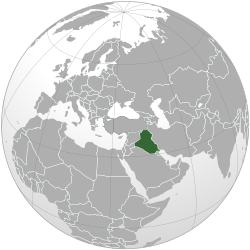User:Jmkoffi/sandbox/iraqwomen'sunion
THE IRAQI WOMEN’S UNION
[edit]Lead Section
[edit]Introduction & History
[edit]Iraqi Women’s Union is an organization focusing on charitable work, while focusing on opportunities for women to share their ideas and progre
ss their rights, founded after the Arab Women’s Congress in Cairo. The Union believed that women had to ‘progress’ before being given full citizenship rights, which was called the “new woman” rhetoric, and the modern woman was “educated, professional, patriotic, and a capable citizen willing to build the modern state.”
Around the 1920s, as female advocacy increased with the introduction of the Women's Awakening Club, there were large debates on what modernization entailed. The main demographic against women's rights at the time was male traditionalists. The start of women's rights-oriented organizations signified the start of a long movement. In the 1940s, during the wake of the second world war, there was a rise in organizations devoted towards democracy and improving women's literacy.
The Iraqi Women’s Union was founded in 1945 as a coalition to support and coordinate cooperation across existing women’s associations in Iraq with the aim of raising their social, civil, and economic position, as well as improving their health and legal status. Origins in 1945 are motivated by increasing desperation of circumstance. From 1920s onwards Baghdad had become a center of rural-urban migration, many fleeing the land-tenure system which left them indebted and subjugated to landlords and sheiks. Mass immigration provokes health and social crises in Baghdad which escalate over the course of the 30s. Activity (by and for women) begins to alleviate these conditions. Iraqi Women’s union members frequently members of the elite, feel a “patriotic duty” to involve themselves.
In 1947, after a government crackdown, the members of the smaller Women’s League Society were expelled from the Union given their left-wing standing. Split into two: the Iraqi Women's Union on the one hand and the League for the Defense of Women's Rights on the other. IWU continues to work within the status quo order and enjoys support from the government and royal family. Primarily focused on legal/constitutional reformist measures to enact change, very careful not to criticize the regime, focus primarily on things like illiteracy, poverty and disease—no mass mobilization.
Background
[edit]The first women’s organization in Iraq was founded in 1923, and gained political and social spaces by participating in the country’s independence movement, from the beginning of the British occupation, to the mandate period, and into an independent Iraq (both pre- and post-revolution).
Prominent organizations included the Red Crescent Society, the Child Protection Society, the Houses of the People Society, and the Women’s League Against Nazism and Fascism. The 1940s saw such organizations gain momentum, and women’s groups rose with charitable, political, religious, and feminist ambitions.
The IWU was founded as an umbrella organization of Women’s groups in Iraq. emerging out of the Egyptian Feminist Union conference of December 1944. There are some feminist critiques that the Union had classist influences and was primarily a group of upper-class women largely connected with the political establishment, which did contribute to the splitting off of leftist and communist organizations.
Despite these critiques, the Union was active over two decades in charity work, education, liaising between women’s groups, and also advocating for social taboos like sex work, divorce, custody, working rights for women, and property rights.
Activities
[edit]Activities of the Union included: “The society opened several clinics in Baghdad, including one in 1946 in Shaykh Omar, a migrant slum adjoining the sewage dumps. Observers reported that disease was rampant among its poor and neglected inhabitants, with infant mortality reaching 250 per thousand; children had a 50:50 chance of reaching the age of ten. The clinic provided fresh milk, fish oil, and clothing for babies and inoculated children against typhoid and smallpox. The number of people assisted by this clinic grew steadily, reaching about 30,000 in 1948. The society operated several other projects for urban mothers and children. In 1953 the society cared for almost 100,000, visiting 4,500 homes to instruct mothers on how to breastfeed and raise their children. Almost 18,000 women attended lectures on these subjects, and more than 2,000 pregnant women received attention. The society claimed that from its inception and due to its efforts, child mortality rates dropped from thirty-three percent in the mid-1940s to three percent in the mid-1950s. In 1959, the rule of Iraq (Abd al-Karim Qasim) passed the Personal Status Code of 1959. This law ensured women equality in polygamy, inheritance, marriage consent and divorce. The progress seen in Status Code is largely attributed to the political organizations which campaigned for women's rights.
An important figure for the Iraqi Women's Union was Al-Shaikh Da’ud (the first female lawyer in Iraq). Her work details that the modernizations of Iraq relied on the socially and economically aware Iraqi women who aimed for modernization. The ideas of increased education, work rights, and legal/political representation were greatly emphasized for the process of modernization.
Structure
[edit]There were five groups represented in the union: the women's branches of the Red Crescent Society, the Child Protection (or Welfare) Society and the Houses of the People Society, the Women's Temperance and Social Welfare Society, and the Women's League Society (later replaced by the Arab Home Society Arab Home Society). Each society had three members on the Union’s executive, comprising 15 total.
The union helped coordinate cooperation between these groups, organized special lectures, films, and plays, aided in natural disasters and supported women’s political participation. Historians suggest that membership in the group assisted women in feeling supported in conducting open political activism, contributing to the annulment of legal prostitution, concerns over child custody after divorce, and the requirement that judicial courts include a woman on their panel. The organization promoted advancement of working conditions for nurses, and lobbied for the protection of property rights throughout the annulment of family endowments.

